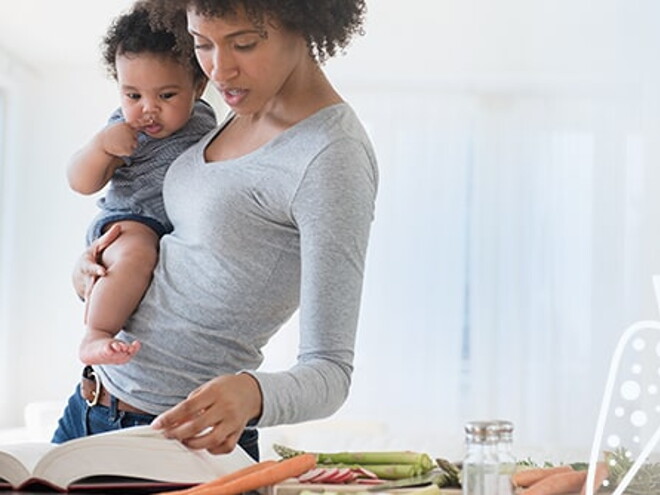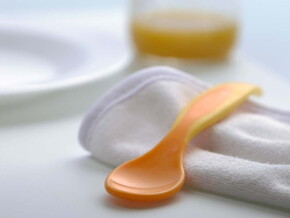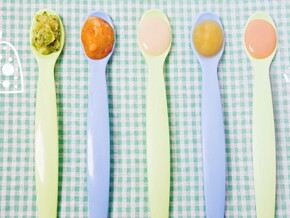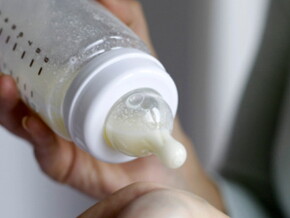
As your baby grows and develops they’ll be able to eat a wider range of foods. Introducing new flavour combinations to your baby’s meals can be fun and rewarding. Your baby may need up to eight tries of a new food, offered over several days or weeks, to accept it so don’t be easily discouraged.
When introducing new foods, remember to keep an eye out for signs of intolerance and allergy. Although breast milk and/or formulas will remain their main source of nutrition until their first birthday, their menu can be expanded now. You can start offering combinations of foods once they have tried and mastered single-ingredient foods. Exposing them to new flavours and textures now may make them more likely to eat new foods in the future, so get creative!
Thank goodness for fruits and vegetables
Fruits and vegetables are perfect for your baby because they are rich in important nutrients, including:
- vitamin A—for healthy eyesight and cell growth
- vitamin C—an antioxidant that helps keep gums healthy, and can help babies absorb iron when eaten at the same time as iron-rich (non-meat) foods, such as fortified baby cereal
- potassium—a mineral that helps your baby’s nervous system and muscles work well
- fibre—helps prevent constipation and can help keep your baby’s digestive system moving
Here are 10 tips for introducing new textures and flavours of fruit and vegetables, and other foods, into your baby’s diet:
- Don’t give up easily
Studies have shown that babies may need to try a food up to eight times before they accept it. In a series of studies, seven-month-old babies who learned to like a previously disliked vegetable—by tasting it several times—were shown to continue to like that vegetable through the age of 15 months, three years, and up to six years. Your baby may make funny faces (or looks of surprise) when trying a new food, but it is often only because it is a food they haven’t tasted before. It doesn’t mean they don’t like it. Even if they spit something out, don’t be discouraged, it doesn’t mean they will never eat that food. Be patient and offer it again the next day. Foods that, at first, it seems your baby doesn’t like may become firm favourites after several tastes over a few days or weeks. Even a tiny taste (one small teaspoon) can help him learn to like a new vegetable. These flavours and textures are new, and your baby needs the opportunity to learn to accept and enjoy them. - Follow the 1-in-3 approach
Offer your baby one new food about every three days so you can watch for signs of intolerance or sensitivity. If you suspect a reaction, don’t give them any more of that particular food and speak to your healthcare provider. Be aware that an allergic reaction is different to your baby spitting out food because the flavour or texture is new, or they’re full (see Hungry or full? Nine faces of feeding). - Make mealtimes social
Sit at the table with your baby while they’re in their high chair. Smile, chat with them, and look into their eyes. Use simple words and an upbeat tone as you tell them “here comes a bite” and let them eat at their own pace. Making mealtimes a positive experience, and establishing healthy eating habits now, may last a lifetime. - Feed frequently
Babies have tiny tummies compared to adults, so make their portions small. Expect to eventually offer them three meals and two or three snacks per day. - Try traditional favourites first
Once your baby is eating a good source of iron, such as iron-fortified baby cereal or pureed meat, to help meet their iron needs for healthy brain growth, don’t be afraid to then offer strongly flavoured fruits and vegetables. Although the natural sweetness of apples, bananas, carrots, and sweet potatoes make them favourite first foods for many babies, try offering a mix of different tastes. Babies will accept a wide variety of fruits and vegetables, even those we think are bitter, and now is the perfect time to introduce these flavours. - Mix new with old
First try of a new taste? Combine it with a familiar favourite to help your baby learn to accept and enjoy it. - Eat a rainbow
Different-coloured fruits and vegetables contain different nutrients, so try to include a variety of hues in your baby’s bowl over the next few weeks. This will give your little one the vitamins and minerals they need to grow and develop healthily. Fruits and vegetables also contain phytonutrients—chemical compounds produced by plants that have benefits to health that scientists are still discovering. - Don’t forget dairy
Your little one can now have yogurt, which provides calcium and important nutrients to help build strong bones while he’s growing fast. Plain, unsweetened yogurts, full-fat yogurts are the best choice for babies. - Hold the sugar
There’s no need to add sugar when you’re preparing food for your baby, or to offer them sweetened beverages. Experts recommend not introducing fruit juice in the first year because of its relatively high natural sugar content. As well, pureed or mashed fruit has some fibre that juice will not. If you do choose to offer juice after one year of age, give it to them in an open cup rather than a bottle, and limit it to no more than 120ml (4oz) per day. Avoid juice drinks or other blended juice-like beverages that contain added sweeteners. Always check the label. - Drink up
During their first year, breast milk and/or formula are your baby’s main source of nutrition and fluids. Now is a good time for your baby to learn to enjoy water. Try offering a little (30-60ml or 1-2oz) in an open cup with meals and snacks to help them enjoy water as a thirst-quencher that isn’t sweetened. Drinking water will help as they learn to move food around their mouth and swallow, as well as teaching them to drink from a cup. And, introducing your baby to drinking water now, can help them enjoy it as their drink of choice in the future. It’s important to be aware that cow’s milk shouldn’t be given as a drink until after your baby’s first birthday.
Ready for texture?
Once your baby is used to eating smooth, pureed foods, they may be ready for some foods with a thicker texture or small, soft lumps. “Babies develop the oral motor skills for managing texture between six and 12 months of age,” says Sarah Smith-Simpson, PhD, Principal Scientist and Feeding Expert at Nestlé Nutrition in Michigan, USA. “Their tongues learn to move solid food around their mouths so that it can be swallowed, and babies will practice moving their tongues side to side when eating more advanced textures with lumps. These skills are based on experience with texture, rather than developing at a certain age.”
Here are a few ideas for introducing texture:
- try mashed banana or mashed avocado instead of pureed
- offer well-cooked scrambled egg
- add couscous, rice, or tiny pasta pieces to smooth purees
- prepare cooked or soft foods, such as carrots or sweet potatoes, using a hand blender (using short bursts), masher, or fork until you have a chunky, mashed texture
- add iron-fortified baby cereal to pureed fruits & vegetables or to plain, full-fat yogurt.
Sources
Black MM, Aboud FE. Responsive feeding is imbedded in a theoretical framework of responsive parenting. J Nutr 2011; 141(3):490-4.
Joint statement of Health Canada, Canadian Paediatric Society, Dietitians of Canada, and Breastfeeding Committee for Canada. Nutrition for Healthy Term Infants: Recommendations from Six to 24 Months. 2014. https://www.canada.ca/en/health-canada/services/food-nutrition/healthy-…
Maier A, Chabanet C, Schaal B et al. Effects of repeated exposure on acceptance of initially disliked vegetables in 7-month old infants. Food Quality and Preference 2007; 18:1023-32.
Maier-Noth A, Schaal B, Leathwood P et al. The lasting influences of early food-related variety experience: A longitudinal study of vegetable acceptance from 5 months to 6 years in two populations. PLoS One 2016; 11(3): e0151356. doi:10.1371/journal.pone.0151356.
Nicklaus S, Demonteil L, Tournier C. Modifying the texture of foods for infants and children. In: Modifying Food Texture, Volume 2. Elsevier, 2015: 187-222.
Nicklaus S. Complementary feeding strategies to facilitate acceptance of fruits and vegetables: A narrative review of the literature. Int J Environ Res Public Health 2016; 13(11): 1160; doi: 10.3390/ijerph13111160.





















